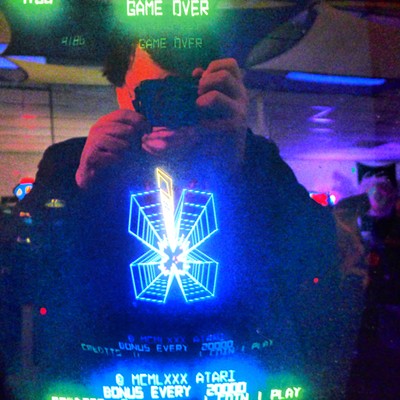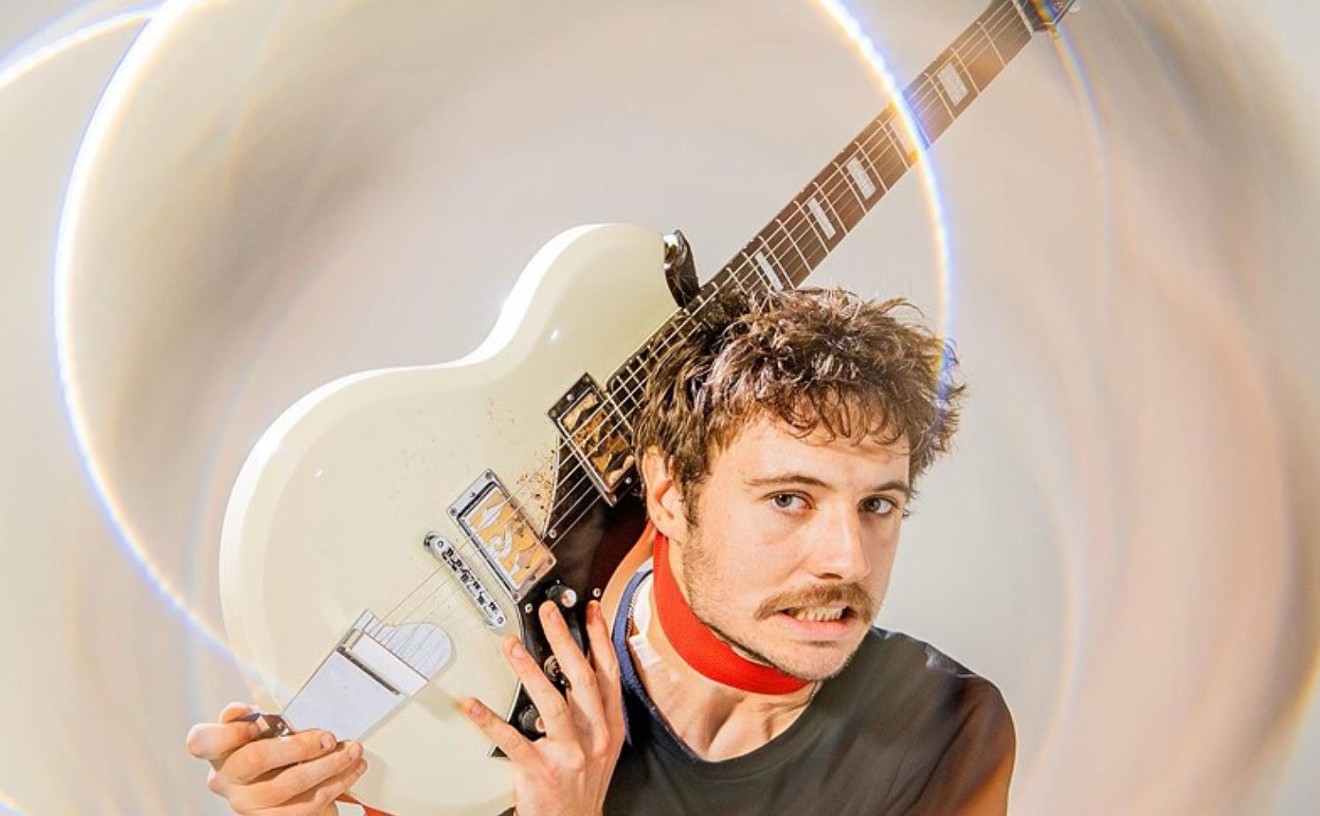Medina currently lives in Egypt but will be on hand for the release party; we had a chance to interview him via e-mail about the book and how it came about.
Tom Murphy: What inspired you to make this book? What year did you get going with it? Was it originally conceived to include illustrations? Why did that seem important then and later on?
Bob Rob Medina The idea for the book was conceived when the first round of punk-rock-related books started appearing. I thought Banned in DC was a great book of anecdotes and photographs documenting the Washington punk and hardcore scene. I wanted to do a Denver version of that and realized there weren't many photographs of bands from the time period and not much info out there other than zines and fliers. I came up with the title in 1997 after posting up a few fliers at places like Wax Trax and Jerry's Records pre-social media. Other than Duane Davis handing me a stack of papers and Jill Razer putting me in contact with people and giving access to a few photographs, I didn't have much to work with. When I moved to Ethiopia for work, I had a lot of down time and was stuck, artistically. I started redrawing photos of Denver bands I had taken with brush and ink. One of the first drawings I made was of the Fluid, and friends on Facebook were really into it, so I continued. A lightbulb went off in my head, and I started dusting off old stories I had written. I started reconnecting with old friends. The ideas just exploded and I dove in head first. I wanted the lines and brush strokes of the drawings to symbolize the aesthetic and personalities of the band and people I interviewed. You can say I thought about the book for twenty years and wrote it in eighteen months.
You included a section on zines. What were the important zines to you at that time? Where did you find your first issue of Tom Headbanger's Rocky Mountain Fuse? Did you read that zine, to which Gil Asakawa contributed before, or maybe even while, his time with Westword and the Denver Post?
My favorite part of any punk scene was the concept of DIY fanzines. You didn't need talent, writing or layout skills, just passion. My first issue of RMF was a hand-me-down from a friend at school. I thought it was funny and crude. I would pick up Archy-Type Morality and Lick It Up at shows. I though they were fantastic. I had a huge zine collection at one time before I gave most [of it] away. I didn't ever see Gil's zine.
Did more mainstream publications, like the daily newspapers or even an alternative weekly like Westword, write about the punk and underground music scene generally that you were a part of? Did zines fulfill the role that those papers now undertake? Why were zines important in the local scene, and was there any rivalry between them in terms of what they covered?
I thought Westword was generous in its coverage of punk; to me [Westword] seemed connected to the people. Gil [Asakawa] and Roxanne [Alday] would often put a blurb in about shows or otherwise. The Rocky Mountain News also featured punk way more than the Post ever did. Maybe the News found punk amusing. They had the Clash and X on the covers of their weekend section. One Sunday section was dedicated to "Punks." I respected Westword and the News for reaching out and simply not ignoring punk or being judgmental. People that made zines were individuals and wrote about or put images of what was important to them. They gave you an insight and street-level view of what was going on at shows, tensions within the scene, bands that were accused of selling out. Zines were the true document of a punk scene because of the diverse subject matter.
Did the fallout of the oil bust around 1982 have an impact on your life outside of punk and on the underground music scene at that time?
Paul Dickerson anthologizes that topic pretty well in the book: How the oil bust left a bunch of people who wanted to live outside the mainstream to take advantage of an almost vacant city center. Downtown Denver was a space where artists, anarchists, punks, or whoever wanted to drop out could flourish. It was easy to make a scene of any sort without drawing too much attention.
How long did it take you to track down some of the people you interviewed for the book? Is there anyone that you could have interviewed that you would like to have that perhaps someone else might be able to track down for their recollections?
I wanted to talk to a lot more people, and I sought a cross section of what was considered punk and underground from people who were into noise/industrial to hardcore punk to skinheads to business owners [and] fanzine writers. With social media, it was pretty easy to track people. I talked with people who I never thought I would, like Jeff [Reifsteck] from the Rok Tots, Nancy Kennedy, Shawn Slater [and] Marilyn [Megenity] from the Mercury Cafe. I'm super-grateful that anyone cared enough to participate. One common theme I kept running into was everyone wished they would have taken more photographs. I did wish I would have talked with Ricky Kulwicki and Phil the Fan before they passed. Some people didn't want to be mentioned, and I tried to respect that as much as I could, but sometimes it was impossible. The readers need to keep in mind, when people talked, they were talking about some [thirty-] odd years ago.
What informed the structure of the book and the interviews?
There was no formal structure other than I wanted to cover as much of the underground scene as I could. The main focus is from 1982-ish to early 1987. There is a little before like the Rok Tots and a little after. I wanted to state my story to paint my version of growing up in Aurora and what I had to endure not fitting in. I think the other stories reinforce the isolation of being in the middle of the country.
The rough end year of the book corresponds well with the collapse of hardcore on the national level as chronicled in Steven Blush's American Hardcore. Why was that kind of an end date for you in terms of the scope you wanted to have for the book? Certainly that year was important for Denver, too, because it was the year that three of the most important bands of the following decade would get going: Twice Wilted, Warlock Pinchers and the Denver Gentlemen.
What kind of subculture crossover existed in the years your book is covering? The Grove you refer to as a kind of Goth club. Were those worlds so far apart? Less far apart than punk and metal?
I think goth and punk mixed well, metal not so much. I recently picked up The Decline of Western Civilization [boxed set] before heading back to Egypt for work. If you watch the original Decline versus the the second, The Metal Years, you will get how punks and metalheads were different. The punks sought social change and challenging the status quo, while metal sought pussy and Jack Daniel's. I think in the early days, everyone mixed and got along, and punks were more open to various types of music. Not so much later on, when everything was broken down into categories.
In the book, you dedicate a good deal of space to the experimental music scene, and you talk about people who played punk but also played what might be called more unusual music. What kind of overlap was there in terms of people involved and the venues for each? What did punks think of that music, do you think, and vice versa?
The original punk scene in Denver from the '70s until the mid-'80s — people were more open, and punk had a wider definition. You have the Young Weasels and the Frantix and Acid Ranch and Human Head Transplant, and all could arguably be considered punk. To me, I define punk more as an attitude and not so much a sound. Sure, there was a lot of overlap. I thought it was cool seeing older people at hardcore shows. I liked going to see weird shit at the Art Department or spaces on Larimer Street. I was more into punk and hardcore, but I had an appreciation for anything that went beyond the norm, as I thought most people in Denver did. I grew up where there was only one scene, and somehow all these people blended into each other's lives.
Is there any chance of a companion soundtrack, as it were, for the book?
Pete Flye and others thought there should be. I thought [the] Capitol Hillbillies tape was the best compilation to come out of Denver; it truly captured the spirit of the times with the wide range of sounds from noise to punk. I would have liked for there to be something. Maybe down the line there might be something to download that will have Uberfall and Peace Core Songs.
Did Sonny Kay do the artwork for the cover? Why did you want Sonny to do the layout and design? How did you come to know him and become familiar with his work?
I did all the artwork for the book. Sonny and I were roommates when I was attending CU Boulder. We played in the band Savalas, and he started promoting shows when I was getting out of it. We have known each other since '89. I wanted Sonny to do the layout from day one. He created the aesthetics of the book; it would have been a different book without him. I've watched him evolve over the years and truly trust him. He has a rare talent, and I think we synergized well on the project. David the editor helped me express my thoughts better, and I love the books he's written. It was a great team to work with.











